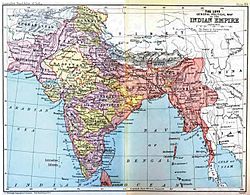Kepimpinan dan wilayah di India British
Penampilan
(Dilencongkan daripada India British)
 Entiti Imperial India | |
| India Belanda | 1605–1825 |
|---|---|
| India Denmark | 1620–1869 |
| India Perancis | 1668–1954 |
| Casa da Índia | 1434–1833 |
| Syarikat Hindia Timur Portugis | 1628–1633 |
| Syarikat Hindia Timur | 1612–1757 |
| Pemerintahan syarikat di India | 1757–1858 |
| Raj British | 1858–1947 |
| Pemerintahan British di Burma | 1824–1948 |
| Kerajaan kecil India | 1721–1949 |
| Pembahagian India | 1947 |
Wilayah India, Kepimpinan India British terdahulu dan masih terdahulu, 'bandar Kepimpinan', ialah bahagian pentadbiran British di India. Secara kolektif, mereka dipanggil 'India British'. Dalam satu bentuk atau yang lain, mereka wujud antara 1612 dan 1947, secara konvensional dibahagikan kepada tiga tempoh sejarah:
- Pada 1612–1757, Syarikat Hindia Timur membentuk "kilang-kilang" (pos perdagangan) di beberapa tempat, kebanyakannya di pesisir India, dengan persetujuan empayar Moghul atau pemimpin tempatan. Saingannya ialah syarikat perdagangan Portugal, Denmark, Belanda dan Perancis. Pada pertengahan abad ke-18, tiga "kota kepimpinan": Madras, Bombay, dan Calcutta diperluas.
- Pada zaman pemerintahan syarikat di India, 1757–1858, Syarikat tersebut memperoleh kedaulatan di sebahagian besar India, yang kini disebut "Kepimpinan".
- Selepas Pemberontakan India 1857, sisa-sisa kekuatan syarikat tersebut dipindahkan ke Mahkota. Di Kemaharajaan British yang baru (1858–1947), kedaulatan dibahagikqn dalam beberapa daerah yang baru, seperti Dataran Tinggi Burma. Namun, kepimpinannya diturunkan menjadi "Wilayah".[1]
Catatan
[sunting | sunting sumber]- ^ Imperial Gazetteer of India vol. IV 1908, halaman 5 Quote: "The history of British India falls ... into three periods. From the beginning of the 17th to the middle of the 18th century, the East India Company is a trading corporation, existing on the sufferance of the native powers, and in rivalry with the merchant companies of Holland and France. During the next century the Company acquires and consolidates its dominion, shares its sovereignty in increasing proportions with the Crown, and gradually loses its mercantile privileges and functions. After the Mutiny of 1857, the remaining powers of the Company are transferred to the Crown ..." (p. 5)
Rujukan
[sunting | sunting sumber]- The Imperial Gazetteer of India (26 vol, 1908–31), highly detailed description of all of India in 1901. online edition
- Imperial Gazetteer of India vol. II (1908), The Indian Empire, Historical, Published under the authority of His Majesty's Secretary of State for India in Council, Oxford at the Clarendon Press. Pp. xxxv, 1 map, 573
- Imperial Gazetteer of India vol. III (1908), The Indian Empire, Economic (Chapter X: Famine, pp. 475–502), Published under the authority of His Majesty's Secretary of State for India in Council, Oxford at the Clarendon Press. Pp. xxxvi, 1 map, 520
- Imperial Gazetteer of India vol. IV, The Indian Empire, Administrative, Published under the authority of His Majesty's Secretary of State for India in Council, Oxford at the Clarendon Press. Pp. xxx, 1 map, 552
Bacaan lanjut
[sunting | sunting sumber]- Bandyopadhyay, Sekhar (2004). From Plassey to Partition: A History of Modern India. New Delhi and London: Orient Longmans. Pp. xx, 548. ISBN 81-250-2596-0.
- Brown, Judith M. (1994) [First published 1985]. Modern India: The Origins of an Asian Democracy (ed. 2nd). Oxford University Press. Pp. xiii, 474. ISBN 0-19-873113-2.
- Copland, Ian (2001). India 1885–1947: The Unmaking of an Empire (Seminar Studies in History Series). Harlow and London: Pearson Longmans. Pp. 160. ISBN 0-582-38173-8.
- Harrington, Jack (2010). Sir John Malcolm and the Creation of British India. New York: Palgrave Macmillan. ISBN 978-0-230-10885-1.
- Judd, Dennis (2004). The Lion and the Tiger: The Rise and Fall of the British Raj, 1600–1947. Oxford and New York: Oxford University Press. Pp. xiii, 280. ISBN 0-19-280358-1.
- Majumdar, R. C.; Raychaudhuri, H. C.; Datta, Kalikinkar (1950). An Advanced History of India. London: Macmillan and Company Limited. 2nd edition. Pp. xiii, 1122, 7 maps, 5 coloured maps.
- Markovits, Claude (ed) (2005). A History of Modern India 1480–1950 (Anthem South Asian Studies). Anthem Press. Pp. 607. ISBN 1-84331-152-6.CS1 maint: extra text: authors list (link)
- Metcalf, Barbara; Metcalf, Thomas R. (2006). A Concise History of Modern India (Cambridge Concise Histories). Cambridge and New York: Cambridge University Press. Pp. xxxiii, 372. ISBN 0-521-68225-8..
- Mill, James (1820). The History of British India, in six volumes. London: Baldwin, Cradock, and Joy, 3rd edition, 1826.
- Peers, Douglas M. (2006). India under Colonial Rule 1700–1885. Harlow and London: Pearson Longmans. Pp. xvi, 163. ISBN 0-582-31738-X.
- Riddick, John F. (2006). The history of British India: a chronology.
- Riddick, John F. (1998). Who Was Who in British India.
- Sarkar, Sumit (1983). Modern India: 1885–1947. Delhi: Macmillan India Ltd. Pp. xiv, 486. ISBN 0-333-90425-7.
- Smith, Vincent A. (1921). India in the British Period: Being Part III of the Oxford History of India. Oxford: At the Clarendon Press. 2nd edition. Pp. xxiv, 316 (469–784).
- Spear, Percival (1990) [First published 1965]. A History of India, Volume 2: From the sixteenth century to the twentieth century. New Delhi and London: Penguin Books. Pp. 298. ISBN 0-14-013836-6.
Pautan luar
[sunting | sunting sumber]- Statistical abstracts relating to British India, from 1840 to 1920 at uchicago.edu
- Digital Colonial Documents (India) Homepage at latrobe.edu.au
- Provinces of British India at worldstatesmen.org
- Collection of early 20th century photographs of the cities of Bombay, Calcutta, and Madras with other interesting Indian locations from the magazine, India Illustrated, at the University of Houston Digital Library
- Coins of British India